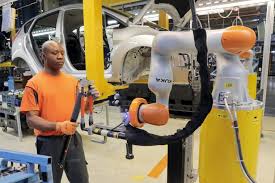
Ford Motor Co. (NYSE:F) has recently disclosed that it is testing new three-feet-tall assembly line robots – also called collaborative robots or co-bots, which were co-developed with KUKA Roboter GmbH, that will automate and speed up its manufacturing processes.
Evaluation Process
The co-bots are currently being tested in two stations at the factory in Cologne, Germany. They help factory workers to install shock absorbers on Ford Fiesta vehicles.
Accordingly, Ford chose to deploy the co-bots on the installation of shock absorbers for the evaluation period because of the task’s vigorous nature. Employees tasked to fit shock absorbers in vehicles usually need to stay on the assembly line for seven or eight hours just to make sure that the shock absorbers are perfectly installed. The job requires extreme strength and accuracy. In line with this, the company deemed the collaborative effort as a necessity.
Ngali Bongongo, one of the workers at the plant, reiterated that the machines offer significant help in accomplishing a tough job and making it much easier.
Sense-and-Stop Technology
The new robots are also smarter. They have been engineered with sensors that can detect arms and fingers, allowing them to automatically stop working once laborers get in the way. This makes working with the co-bots less dangerous.
Ford has been regarded for its sense-and-stop technology that is geared toward making collaborative and harmonious working relationships between robots and humans safer.
How Co-Bots will Transform the Automotive Industry
Karl Henkel, a Ford representative, noted that the company plans on deploying the co-bots in other factories once the evaluation confirms their efficiency. He also emphasized that co-bots are not alternatives for human resources. The machines are specifically engineered to work hand-in-hand with humans. What’s more interesting is that the co-bots can even be programmed to give massages and make coffees.
Should the co-bots be proven effective in the overall factory work, it would not be too long before robots and humans can seamlessly work together for more efficient automotive manufacturing procedures. Aside from that, Ford can also look at other assembly line tasks where the contribution of co-bots can become valuable.




